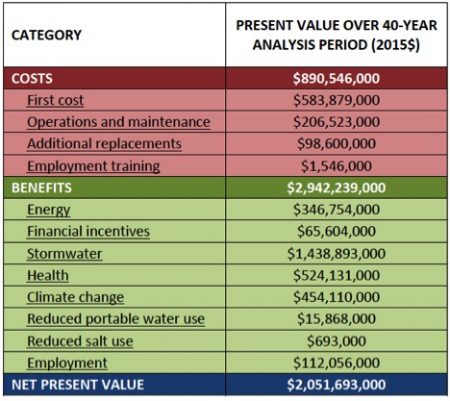We have long known that smarter material choices for our roofs and pavements would lead to significant improvements in urban economies and quality of life. Now, a report for the District of Columbia municipal government shows just how big those net benefits can be by evaluating the potential costs and benefits of urban “sun and rain management” in the District. Cities that manage the sun’s energy with cool and green roofs and pavements and manage stormwater with green infrastructure will unlock billions in net benefits over the life of those investments.
The report documents how D.C. could save $2 billion with smart surface strategies, such as cool roofs, green roofs, solar PV and porous pavements while enhancing health and livability and cutting summer peak temperatures.

When increased tourism from more comfortable outdoor conditions are factored in, the net present value benefit exceeds $5 billion! Partners in this work include the American Institute of Architects, the National League of Cities, Global Cool Cities Alliance, DowntownDC Business Improvement District, the U.S. Green Building Council, the National Housing Trust and the Chesapeake Bay Foundation.
The report found that implementing these smart surface solutions city-wide would cost effectively achieve a range D.C. sustainability, livability and competitiveness objectives, including:
Energy: Reduce electricity purchases from the grid by 8.5 percent relative to 2013 consumption levels
Water: Reduce stormwater runoff to protect local water bodies while reducing potable water use
Climate & Environment: By full implementation, reduce greenhouse gas emissions (GHG) by approximately 5.5 percent of 2013 emissions while enhancing resilience to climate change by reducing city temperatures
Built Environment: Improve sustainability performance of new and existing buildings
Nature: Expand tree canopy and other green landscape to enhance city-wide ecosystem
Jobs & Economy: Create more than 2,400 well-paying green jobs in the District over 40 years
Equity & Diversity: Improve livability, particularly in low-income areas that tend to have less green cover and efficient buildings
Health & Wellness: Improve air quality and public health of District residents and visitors
For those looking to recreate this work in their city, the report includes a highly detailed walk-through of the methodology and sources for the findings.
